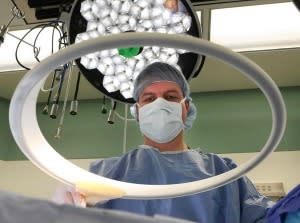By Sandy Swiatek, RN, MSN, CNOR, Perioperative Clinical Instructor & Bariatric Program Coordinator
Safe surgical care is an expectation at Stamford Hospital. Our dedicated team of physicians, nurses and technologists continuously examine advancements in surgical safety and technology. In January of 2015 Stamford Hospital Surgical Services developed a protocol for the use of the newest technology, RF scanning, for all surgical patients to ensure advanced detection of potential retained surgical items.
Surgical items such as sponges, sharps, and instruments may be retained following surgery and lead to serious patient harm. Although the Joint Commission received reports on 772 retained items from 2005-2012, most of these were submitted voluntarily. The "No Thing Left Behind" surgical safety project estimates that the true incidence is closer to 1500 to 2000 unintended retained surgical items each year. Therefore, a Sentinel Event Alert from the Joint Commission recommends use of reliable counting methods along with the use of advanced technologies such as the RF system used at Stamford Hospital.
AORN (The Association of PeriOperative Nurses) also recommends the use of adjunct RF technology to maximize the opportunity to identify missing surgical items. These measures reduce the likelihood of delaying patient care; requiring additional measures such as intraoperative radiographs to locate and retrieve items.
Safe surgical care is an expectation at Stamford Hospital. Our dedicated team of physicians, nurses and technologists continuously examine advancements in surgical safety and technology. In January of 2015 Stamford Hospital Surgical Services developed a protocol for the use of the newest technology, RF scanning, for all surgical patients to ensure advanced detection of potential retained surgical items.
Surgical items such as sponges, sharps, and instruments may be retained following surgery and lead to serious patient harm. Although the Joint Commission received reports on 772 retained items from 2005-2012, most of these were submitted voluntarily. The "No Thing Left Behind" surgical safety project estimates that the true incidence is closer to 1500 to 2000 unintended retained surgical items each year. Therefore, a Sentinel Event Alert from the Joint Commission recommends use of reliable counting methods along with the use of advanced technologies such as the RF system used at Stamford Hospital.
AORN (The Association of PeriOperative Nurses) also recommends the use of adjunct RF technology to maximize the opportunity to identify missing surgical items. These measures reduce the likelihood of delaying patient care; requiring additional measures such as intraoperative radiographs to locate and retrieve items.
So, what is this RFI technology all about?
When a surgical sponge miscount occurs, the scan and detection capabilities of the RF Detection System help the hospital staff determine whether a surgical sponge is still inside the patient. If a scan is completed and shows that the missing surgical sponge is not inside the patient, the system can be used to detect if the sponge is located in the surrounding area of the surgical suite. This may help rectify counts, eliminating the potential need for an x-ray and extended anesthesia time.How does RFI Technology work?
RFI technology was developed to overcome the difficulty of detecting a retained item in human tissue and near metal. The technology utilizes non-ionizing radio frequency to detect small sensors within surgical sponges.Why use RFI Technology?
The medical literature shows that 88% of retained surgical items occur when the count is reported correct. Moreover, 10% of major cases have counts that do not match. These facts strongly support scanning patients on every surgical case.How does RF technology benefit our patients?
When a surgery is completed, a registered nurse waves the wand around the patient and surrounding areas. This process ensures the surgical item counts are correct by both manual counting and RF scanning. This 15 to 30 seconds of scanning at the end of all surgical procedures provides safe patient care you can count on.References
- Egorova, Natalia N., PhD, Alan Moskowitz, MD, Annetine Gelijns, PhD, Alan Weinberg, MS, James Curty, BS, Barbara Rabin-Fastman, MS, Harold Kaplan, MD, Mary Cooper, MD, Dennis Fowler, MD, Jean C. Edmond, MD, and Giampaolo Greco, PhD. "Managing the Prevention of Retained Surgical Instruments: What Is the Value of Counting?" Annals of Surgery 247.1 (Jan 2008): 13-18. Print.
- Gawande et al. NEJM; 2003
Resources
http://www.rfsurg.com/products-and-technology/faqFeatured Expert/ Author









)




